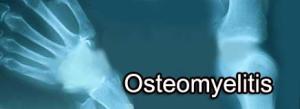

MedFriendly®


Osteomyelitis
Osteomyelitis is an inflammation of the bone marrow (a
tissue that fills the openings inside of bones) and bone
that is next to the bone marrow.
WHAT CAUSES OSTEOMYELITS?
FEATURED BOOK: Osteomyelitis of the Foot and Ankle: Medical Management
The inflammation in osteomyelitis is caused by a local or generalized infection of the bone
and bone marrow. If you want to get a sense of what bone marrow looks like, the next
time you are eating chicken wings, break one of the bones in half and take a look at the
pink stuff inside (bone marrow).
The infection in osteomyelitis is usually caused by bacteria introduced into the body by a
trauma or surgery. The bacteria can also be introduced from the bloodstream or from a
nearby infection. Most often, a group of bacteria know as Staphylococci are what causes
osteomyelitis. Specific types of osteomyelitis are diagnosed depending on the type of
infection that caused the condition.
WHAT BONES DO OSTEOMYELITS AFFECT THE MOST?
In children, the bones that are typically affected by osteomyelitis due the spreading of
infection are the long bones (such as the bones in the legs). In adults, the bones that are
typically affected due to the spreading of infection are the vertebrae (bones of the spine).
"Where Medical Information is Easy to Understand"™
WHAT BONES DO OSTEOMYELITS AFFECT THE MOST?
In children, the bones that are typically affected by osteomyelitis due
the spreading of infection are the long bones (such as the bones in
the legs). In adults, the bones that are typically affected due to the
spreading of infection are the vertebrae (bones of the spine).
WHAT ARE THE SIGNS AND SYMPTOMS OF OSTEOMYELITS?
increasing, severe bone pain (particularly in the early phase),
tenderness, fever, and muscle spasms in specific areas of the body.
Muscle spasms in osteomyelitis often serve to decrease motion or agitation of the condition when the
person tries to move. If osteomyelitis is caused by a trauma or a nearby infection, the pathways of
sinuses (openings in the bone that often contain fluid) may become drained.
HOW IS OSTEOMYELITIS TREATED?
Treatment of osteomyelitis depends on the type of infection that caused the condition. Typically, treatment
involves rest, careful positioning of body parts using pillows and sandbags for good alignment, and taking
antibiotics (drugs that fight bacterial infections) that do not go through the digestive system.
Surgery may be used to take away any bone or tissue that died as a result of the infection. Surgery may
also be used to remove openings inside the bone as a result of the infection. Another reason for surgery
would be to apply artificial devices to stabilize parts of the body affected by this condition or to remove
any such devices that became infected.
Nurses take extra precautions when getting rid of any fluid drainage, due to the infectious nature of this
condition. Nurses also take extra precautions when moving the affected body parts of patients in the early
phase of this condition due to the severe pain that is usually experienced. Physical therapy is often
utilized to treat individuals who are having difficulty utilizing body parts affected by the condition.
WHAT IS THE PROGNOSIS FOR OSTEOMYELITIS?
The prognosis for people with osteomyelitis is variable. Prognosis improves significantly if the condition is
diagnosed within a reasonable amount of time and if the condition is treated aggressively. Prognosis is
usually good in acute (suddenly occurring) cases which have been treated adequately.
Prognosis is worse for chronic (long-lasting cases), even if surgery is sued for treatment. For patients
with resistant osteomyelitis or with extensive disease, amputation may be required. This is especially true
for people with poor blood circulation or diabetes mellitus. Diabetes mellitus is a complex, long-term
disorder in which the body is not able to effectively use a natural chemical called insulin.
WHAT IS THE ORIGIN OF THE TERM, OSTEOMYELITS?
The word "osteomyelits" comes from the Greek word "osteon," meaning "bone," the Greek word "myelos"
meaning "marrow," and the Greek word "itis" meaning "inflammation." Put the words together and you have
"bone marrow inflammation."















